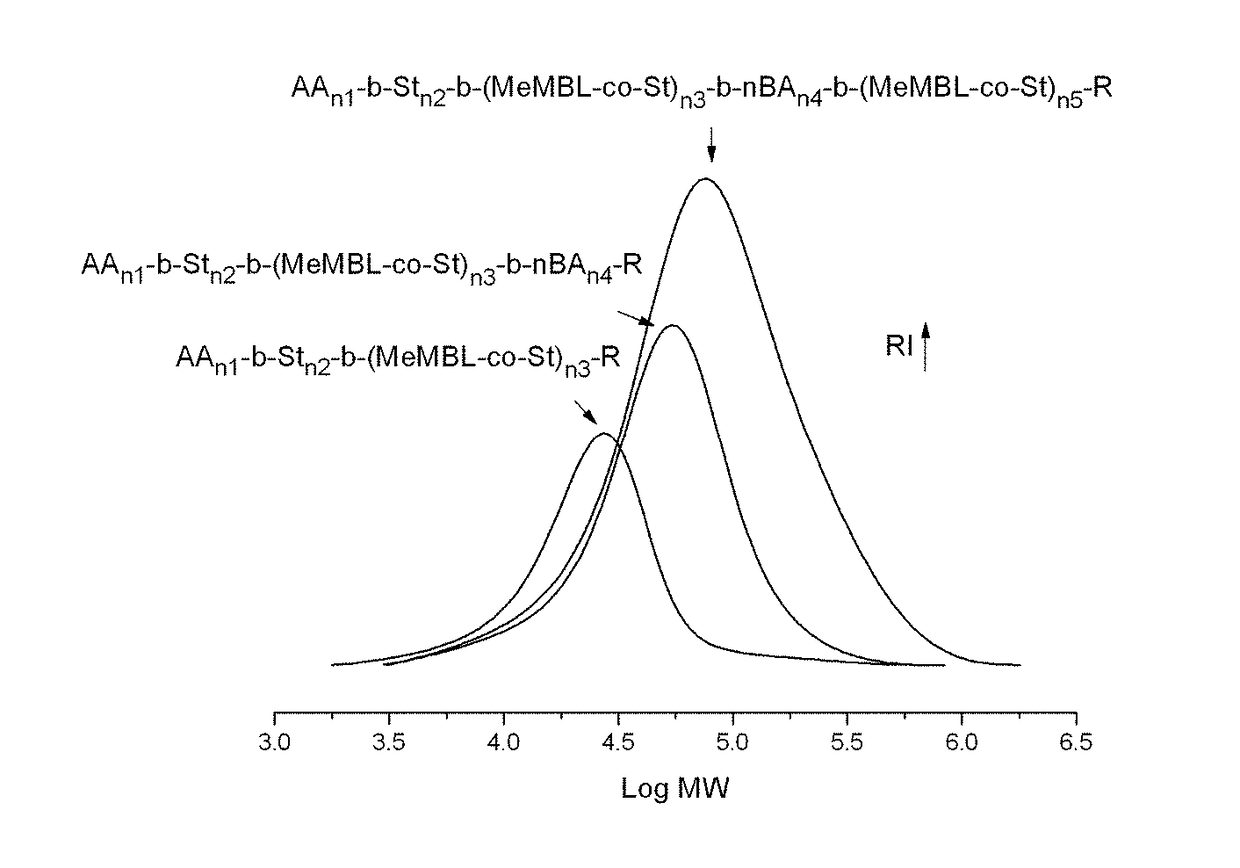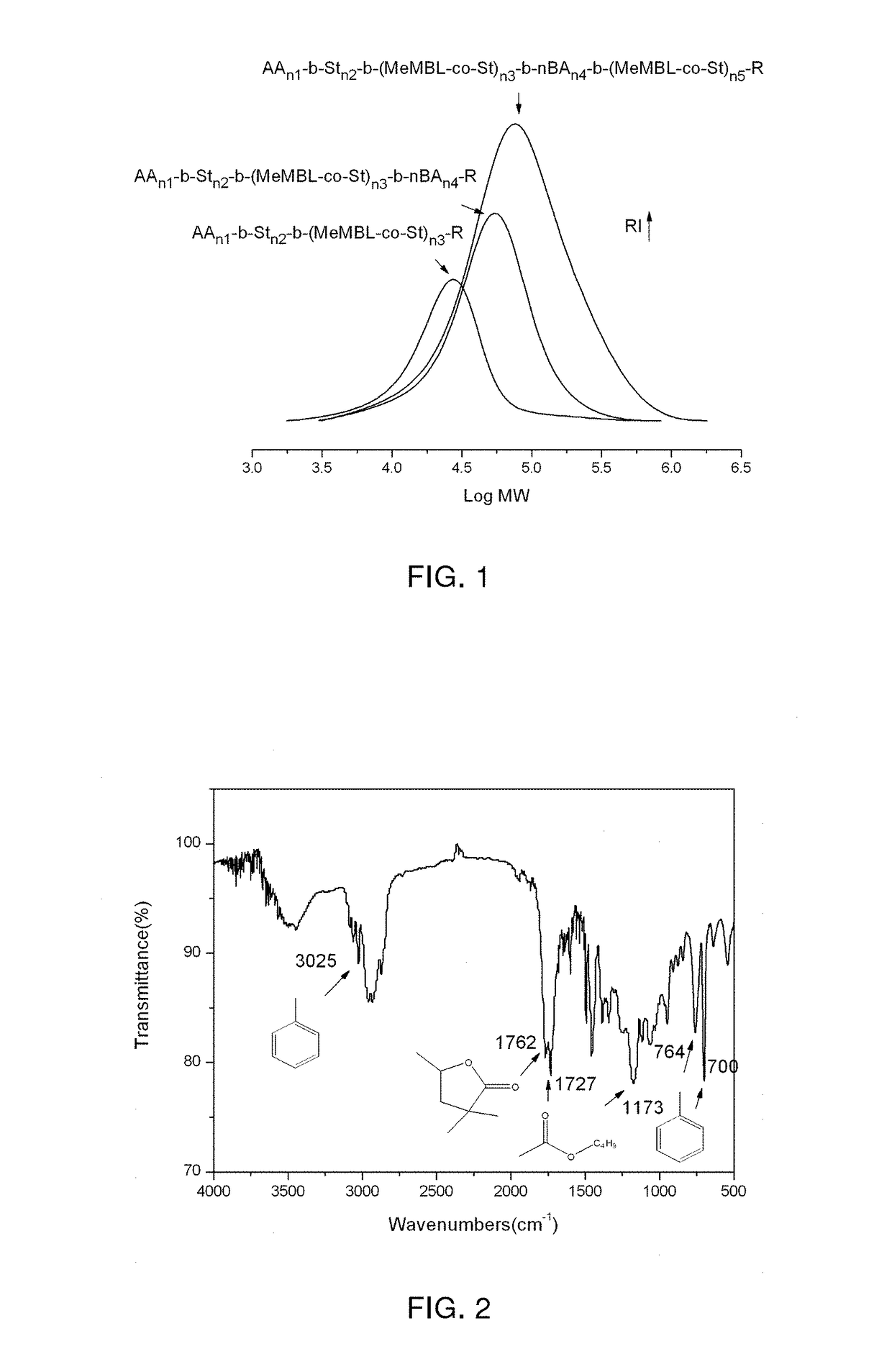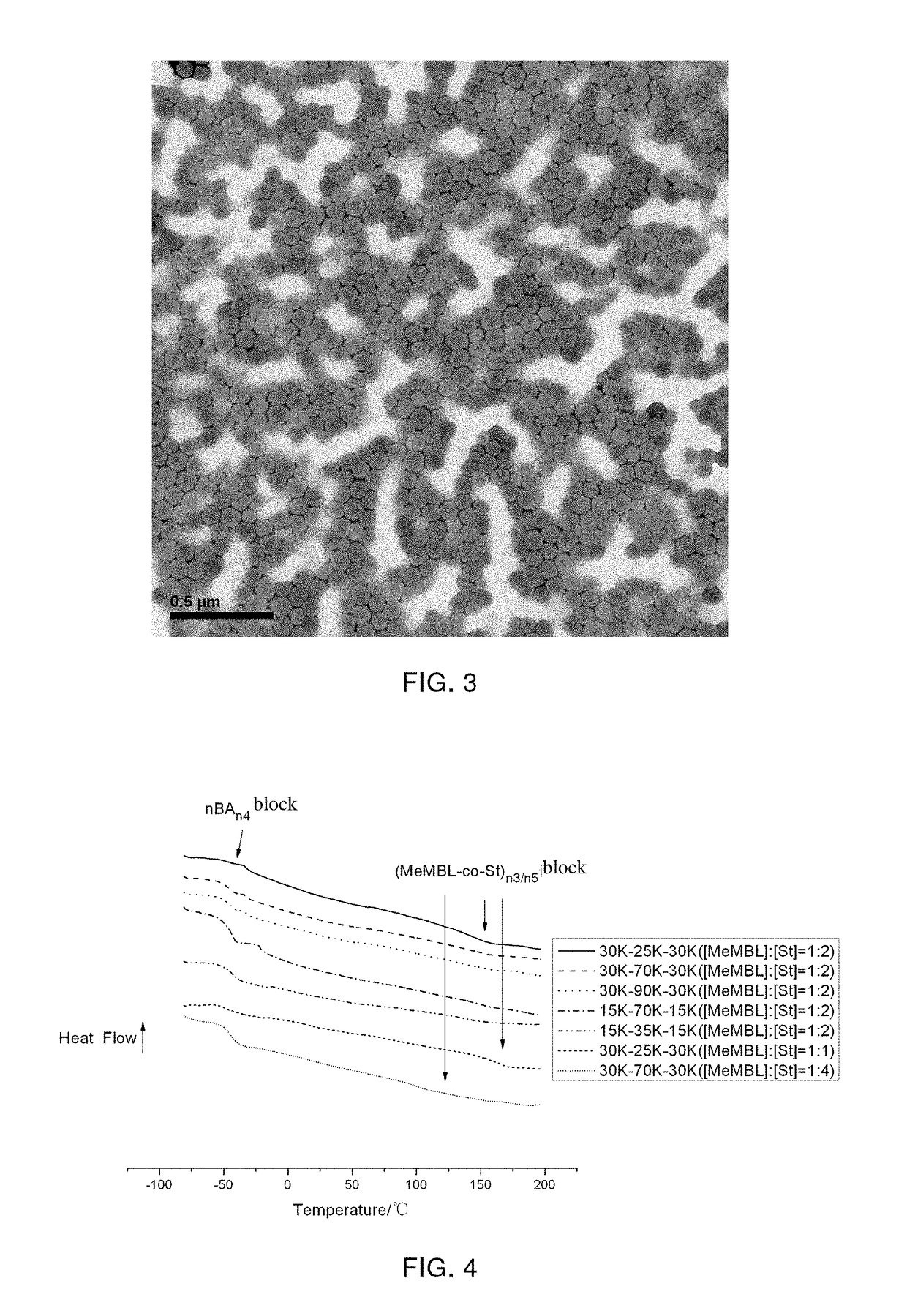Block copolymer comprising a block with glass transition temperature higher than 100° C. and method for preparing the same
a technology of glass transition temperature and block copolymer, which is applied in the field of block copolymer, can solve the problems of large difficulty in direct preparation, sharp decrease in mechanical properties of block copolymer, and limited ionic copolymerization, and achieves high colloidal stability, controlled molecular weight, and favorable to heat transfer and environmental safety.
- Summary
- Abstract
- Description
- Claims
- Application Information
AI Technical Summary
Benefits of technology
Problems solved by technology
Method used
Image
Examples
embodiment 1
(MeMBL-Co-St)n3-b-nBAn4-b-(MeMBL-Co-St)n5 Three-Block with Designed Molecular Weight of 30K-25K-30K, Wherein the Ratio of the Numbers of MeMBL Unit to St Units is 1:2
[0048]First step: dissolving 1.9 parts by weight of amphiphilic macromolecule reversible addition fragmentation chain transfer agent (1) into 85 parts by weight of water under stirring, to form a homogeneous aqueous phase, and then pouring the aqueous phase together with a oil phase composed of 11 parts by weight of St and 6 parts by weight of MeMBL into a reactor and mixing them under stirring, raising the reactor temperature to 70° C., and then introducing nitrogen thereinto for 30 minutes while keeping stirring, and then adding 0.03 parts by weight of potassium persulfate thereinto to initiate polymerization, adding an aqueous solution containing 0.2 parts by weight of sodium hydroxide when the polymerization is conducted for 20 minutes, to continue reacting for 20 minutes to obtain AAn1-b-Stn2-b-(MeMBL-co-St)n3-R po...
embodiment 2
(MeMBL-Co-St)n3-b-nBAn4-b-(MeMBL-Co-St)n5 Three-Block with Designed Molecular Weight of 30K-70K-30K, Wherein the Ratio of the Numbers of MeMBL Unit to St Units is 1:2
[0052]First step: dissolving 1.3 parts by weight of amphiphilic macromolecule reversible addition fragmentation chain transfer agent (1) into 62 parts by weight of water under stirring, to form a homogeneous aqueous phase, and then pouring the aqueous phase together with a oil phase composed of 7.5 parts by weight of St and 4 parts by weight of MeMBL into a reactor and mixing them under stirring, raising the reactor temperature to 70° C., and then introducing nitrogen thereinto for 40 minutes while keeping stirring, and then adding 0.02 parts by weight of potassium persulfate thereinto to initiate polymerization, adding an aqueous solution containing 0.17 parts by weight of sodium hydroxide when the polymerization is conducted for 20 minutes, to continue reacting for 20 minutes to obtain AAn1-b-Stn2-b-(MeMBL-co-St)n3-R ...
embodiment 3
(MeMBL-Co-St)n3-b-nBAn4-b-(MeMBL-Co-St)n5 Three-Block with Designed Molecular Weight of 30K-90K-30K, Wherein the Ratio of the Numbers of MeMBL Unit to St Unit is 1:2
[0056]First step: dissolving 1.3 parts by weight of amphiphilic macromolecule reversible addition fragmentation chain transfer agent (1) into 62 parts by weight of water under stirring, to form a homogeneous aqueous phase, and then pouring the aqueous phase together with a oil phase composed of 7.5 parts by weight of St and 4 parts by weight of MeMBL into a reactor and mixing them under stirring, raising the reactor temperature to 70° C., and then introducing nitrogen thereinto for 30 minutes while keeping stirring, and then adding 0.02 parts by weight of potassium persulfate thereinto to initiate polymerization, adding an aqueous solution containing 0.16 parts by weight of sodium hydroxide when the polymerization is conducted for 20 minutes, to continue reacting for 20 minutes to obtain AAn1-b-Stn2-b-(MeMBL-co-St)n3-R p...
PUM
| Property | Measurement | Unit |
|---|---|---|
| glass transition temperature | aaaaa | aaaaa |
| volume average particle diameter | aaaaa | aaaaa |
| temperature | aaaaa | aaaaa |
Abstract
Description
Claims
Application Information
 Login to View More
Login to View More - R&D
- Intellectual Property
- Life Sciences
- Materials
- Tech Scout
- Unparalleled Data Quality
- Higher Quality Content
- 60% Fewer Hallucinations
Browse by: Latest US Patents, China's latest patents, Technical Efficacy Thesaurus, Application Domain, Technology Topic, Popular Technical Reports.
© 2025 PatSnap. All rights reserved.Legal|Privacy policy|Modern Slavery Act Transparency Statement|Sitemap|About US| Contact US: help@patsnap.com



